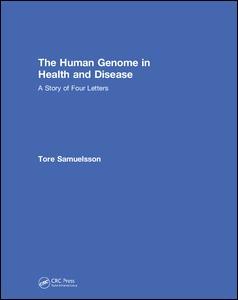Description
The Human Genome in Health and Disease
A Story of Four Letters
Author: Samuelsson Tore
Language: English
Subjects for The Human Genome in Health and Disease:
Keywords
CRISPR Array; genetics; lncRNA HOTAIR; genes; Iron Regulatory Proteins; molecular biology; CAG Repeat; biochemistry; DMPK Gene; disease; CUG Repeat; CAG Triplet; PBD Id; PDB Id; HTT Gene; HBB Gene; UCSC Browser; BRCA2 Gene; Indel Mutations; polyQ Region; UBE3A Gene; SMN Protein; Tad Boundary; Heat Repeat; IRP Protein; Germline Editing; SECIS Element; AU Rich Element; HLA Type; Mutant CFTR Protein
Publication date: 02-2019
· 21.9x27.6 cm · Hardback
Publication date: 02-2019
· 21.9x27.6 cm · Paperback
Description
/li>Contents
/li>Readership
/li>Biography
/li>
The human genome is a linear sequence of roughly 3 billion bases and information regarding this genome is accumulating at an astonishing rate. Inspired by these advances, The Human Genome in Health and Disease: A Story of Four Letters explores the intimate link between sequence information and biological function. A range of sequence-based functional units of the genome are discussed and illustrated with inherited disorders and cancer. In addition, the book considers valuable medical applications related to human genome sequencing, such as gene therapy methods and the identification of causative mutations in rare genetic disorders.
The primary audiences of the book are students of genetics, biology, medicine, molecular biology and bioinformatics. Richly illustrated with review questions provided for each chapter, the book helps students without previous studies of genetics and molecular biology. It may also be of benefit for advanced non-academics, which in the era of personal genomics, want to learn more about their genome.
Key selling features:
- Molecular sequence perspective, explaining the relationship between DNA sequence motifs and biological function
- Aids in understanding the functional impact of mutations and genetic variants
- Material presented at basic level, making it accessible to students without previous studies of genetics and molecular biology
- Richly illustrated with questions provided to each chapter
1. Introduction
2. A Molecular Disorder
3. A Code of Life
4. The Genome
5. Variants in the Human Genome Sequence and Their Biological Significance
6. The Critical Protein Coding Sequences
7. Triplet Repeats and Neurodegenerative Disorders
8. The Untranslated Parts of a Message
9. Exons, Introns, and a Royal Bleeding Disorder
10. The Regulation of Transcription
11. The Noncoding RNAs
12. Computational Methods Are Critical in the Analysis of Molecular Sequences
13. Diagnosing the Genome
14. Correcting Genome Errors
15. Epilogue
Appendixes
Glossary
Recommended Textbooks for Further Reading
Index
These books may interest you

Gene Knockout Protocols 174.06 €


